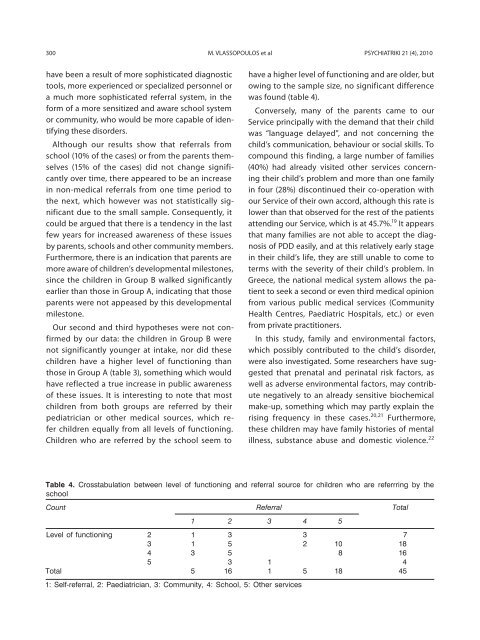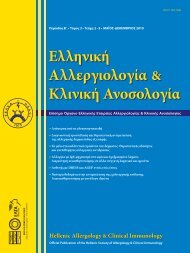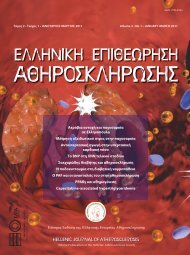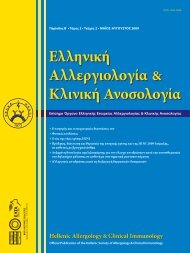300 M. VLASSOPOULOS et al PSYCHIATRIKI 21 (4), 2010have been a result of more sophisticated diagnostictools, more experienced or specialized personnel ora much more sophisticated referral system, in theform of a more sensitized and aware school systemor community, who would be more capable of identifyingthese disorders.Although our results show that referrals fromschool (10% of the cases) or from the parents themselves(15% of the cases) did not change significantlyover time, there appeared to be an increasein non-medical referrals from one time period tothe next, which however was not statistically significantdue to the small sample. Consequently, itcould be argued that there is a tendency in the lastfew years for increased awareness of these issuesby parents, schools and other community members.Furthermore, there is an indication that parents aremore aware of children’s developmental milestones,since the children in Group B walked significantlyearlier than those in Group A, indicating that thoseparents were not appeased by this developmentalmilestone.Our second and third hypotheses were not confirmedby our data: the children in Group B werenot significantly younger at intake, nor did thesechildren have a higher level of functioning thanthose in Group A (table 3), something which wouldhave reflected a true increase in public awarenessof these issues. It is interesting to note that mostchildren from both groups are referred by theirpediatrician or other medical sources, which referchildren equally from all levels of functioning.Children who are referred by the school seem tohave a higher level of functioning and are older, butowing to the sample size, no significant differencewas found (table 4).Conversely, many of the parents came to ourService principally with the demand that their childwas “language delayed”, and not concerning thechild’s communication, behaviour or social skills. Tocompound this finding, a large number of families(40%) had already visited other services concerningtheir child’s problem and more than one familyin four (28%) discontinued their co-operation withour Service of their own accord, although this rate islower than that observed for the rest of the patientsattending our Service, which is at 45.7%. 19 It appearsthat many families are not able to accept the diagnosisof PDD easily, and at this relatively early stagein their child’s life, they are still unable to come toterms with the severity of their child’s problem. InGreece, the national medical system allows the patientto seek a second or even third medical opinionfrom various public medical services (CommunityHealth Centres, Paediatric Hospitals, etc.) or evenfrom private practitioners.In this study, family and environmental factors,which possibly contributed to the child’s disorder,were also investigated. Some researchers have suggestedthat prenatal and perinatal risk factors, aswell as adverse environmental factors, may contributenegatively to an already sensitive biochemicalmake-up, something which may partly explain therising frequency in these cases. 20,21 Furthermore,these children may have family histories of mentalillness, substance abuse and domestic violence. 22Table 4. Crosstabulation between level of functioning and referral source for children who are referrring by theschoolCount Referral Total1 2 3 4 5Level of functioning 2 1 3 3 73 1 5 2 10 184 3 5 8 165 3 1 4Total 5 16 1 5 18 451: Self-referral, 2: Paediatrician, 3: Community, 4: School, 5: Other services
PSYCHIATRIKI 21 (4), 2010 CHILDREN WITH PERVASIVE DEVELOPMENTAL DISORDERS 301In our study we focused on stress-inducing eventsor adverse family functioning as a possible compoundingfactor in these disorders. However, ourresults showed a remarkable lack of stressful factorsin our sample’s children and their families. Mostof the families live harmoniously together, with noblatant socio-economic problems and no other reportedstress-inducing factors. Although there are arelatively large number of immigrant families in oursample, this seems to reflect the evolutions in greeksociety.Our fifth hypothesis concerned our Service itselfand its contribution to this increase in frequency,for instance, whether there are new members inthe professional team, more specialized diagnostictools or indeed any differences in the diagnosticprocedure. 23 However, yet again the results ofour study did not confirm this: the clinicians arethe same people they were 10 years ago, althoughinevitably more experienced. No new diagnostictools are being used. The diagnostic procedure hasnot changed and is strictly multidisciplinary. Eventhe mean number of diagnostic sessions has remainedstable over the years (4.3 sessions) despitethe increased demand. In fact, our study highlightsthe fact that even though our clinical team hasbeen working in the community for over twentyyears and the number of patients is on a constantincrease, service delivery has not changed duringthese years. In a study examining service deliveryfor these disorders in the USA, it was observed thatthere was a 40% decrease in mean service days forthese disorders over the past few years. 24Most of the patients (70%) were examined by achild psychiatrist, psychologist and speech therapistonly. More than 20% of the total sample was offeredtherapy intervention at our Service. These were usuallycases who presented other coexistent factors,such as inadequate parental care, stressful life eventsor other compounding medical factors, which neededfurther investigation.In conclusion, this study offers some preliminarydata on the observed rise in frequency of patientswith pervasive developmental disorders applying toour community-based service. Although the numberof cases in our study is relatively small, it is representativeof the frequency in our catchments area, whichconsists of approximately 600,000 inhabitants in theinner Athens urban area.Our data does not indicate any reasons for thisincrease, however the only plausible explanation,which may only be described as a tendency, is thatof increased public awareness. On the other hand,our study shows that, despite the increase in patientintake without the complementary increase in staffat our Service, services are still delivered accordingto our original multidisciplinary model of conductand according to individual patient needs. Neithermore sensitive diagnostic tools, nor more inclusivediagnostic criteria seemed to play a part in this increaseddiagnosis.LimitationsOur study reports data from a specific communitymental health service and therefore a considerablelimitation is that our sample consists of few cases.More research is necessary to generalize these findingswith larger samples and in other areas and inother services throughout Greece. Epidemiologicalstudies are necessary tools for service providers, butlongitudinal research is also necessary since it allowsthe evaluation of service delivery and provisionwith respect to individual patient needs, somethingwhich is urgently needed by the clinician in the firstline.
- Page 5: PSYCHIATRIKIQuarterly journal publi
- Page 9 and 10: PSYCHIATRIKI 21 (4), 2010 277Άρθ
- Page 11 and 12: PSYCHIATRIKI 21 (4), 2010 279Resear
- Page 13 and 14: PSYCHIATRIKI 21 (4), 2010 HOSPITAL
- Page 15 and 16: PSYCHIATRIKI 21 (4), 2010 HOSPITAL
- Page 17 and 18: PSYCHIATRIKI 21 (4), 2010 HOSPITAL
- Page 19 and 20: PSYCHIATRIKI 21 (4), 2010 287Resear
- Page 22 and 23: 290 P. TZOURAMANIS et al PSYCHIATRI
- Page 24 and 25: 292 P. TZOURAMANIS et al PSYCHIATRI
- Page 26 and 27: 294 PSYCHIATRIKI 21 (4), 2010Resear
- Page 28 and 29: 296 M. VLASSOPOULOS et al PSYCHIATR
- Page 30 and 31: 298 M. VLASSOPOULOS et al PSYCHIATR
- Page 34 and 35: 302 M. VLASSOPOULOS et al PSYCHIATR
- Page 36 and 37: 304 PSYCHIATRIKI 21 (4), 2010Resear
- Page 38 and 39: 306 H. LAZARATOU et al PSYCHIATRIKI
- Page 40 and 41: 308 H. LAZARATOU et al PSYCHIATRIKI
- Page 42 and 43: 310 H. LAZARATOU et al PSYCHIATRIKI
- Page 44 and 45: 312 H. LAZARATOU et al PSYCHIATRIKI
- Page 46 and 47: 314 H. LAZARATOU et al PSYCHIATRIKI
- Page 48 and 49: 316 C. Kouimtsidis PSYCHIATRIKI 21
- Page 50 and 51: 318 C. Kouimtsidis PSYCHIATRIKI 21
- Page 52 and 53: 320 C. Kouimtsidis PSYCHIATRIKI 21
- Page 54 and 55: 322 C. Kouimtsidis PSYCHIATRIKI 21
- Page 56 and 57: 324 PSYCHIATRIKI 21 (4), 2010Specia
- Page 58 and 59: 326 B.J. HAVAKI-KONTAXAKI et al PSY
- Page 60 and 61: 328 B.J. HAVAKI-KONTAXAKI et al PSY
- Page 62 and 63: 330 B.J. HAVAKI-KONTAXAKI et al PSY
- Page 64 and 65: 332 PSYCHIATRIKI 21 (4), 2010Genera
- Page 66 and 67: 334 C.I. Istokoglou et al PSYCHIATR
- Page 68 and 69: 336 C.I. Istokoglou et al PSYCHIATR
- Page 70 and 71: 338 C.I. Istokoglou et al PSYCHIATR
- Page 72 and 73: 340 PSYCHIATRIKI 21 (4), 2010• 10
- Page 74 and 75: SUBMISSIONPapers either in English
- Page 76 and 77: ΥΠΟΒΟΛΗ ΕΡΓΑΣΙΩΝΟι
- Page 78: ΣΥΝΟΔΕΥΤΙΚΟ ΕΝΤΥΠΟ













